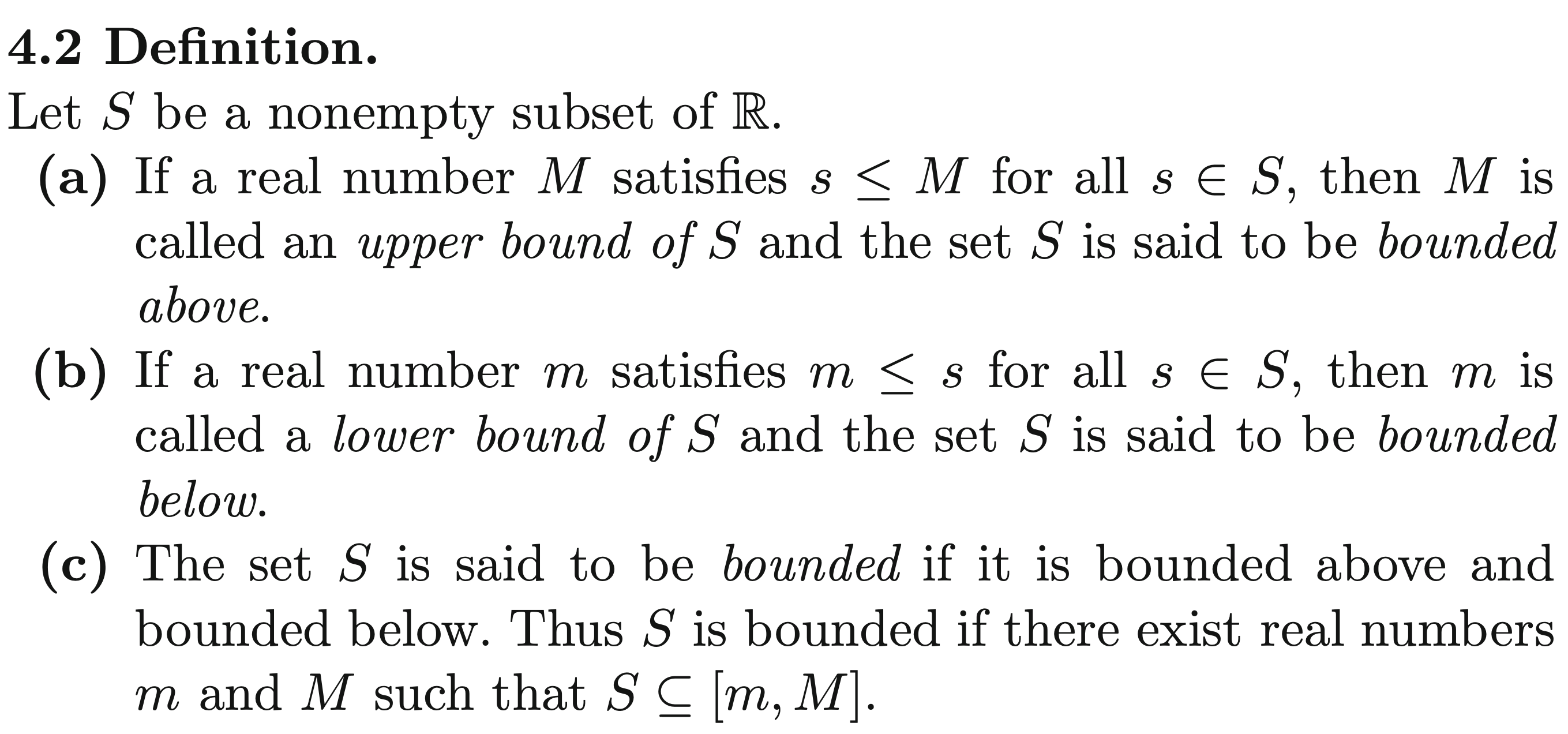The completeness axiom
This is the axiom that guarantees that has no gaps.
Some really elementary proofs. Here is a rigorous definition of min and max:
 Apart from that, remember
Apart from that, remember [ is inclusive and ( is exclusive.
Here is the given definition:

From here, notice that min is and max is . has no min and no max. has a min but no max.
Remember, through an introductory proof we know that is not rational. Thus we can say the following set has no max, but does have a min:
 Where min is 0, but there is no max.
Where min is 0, but there is no max.
Apart from this, and have no max or min. has a min of
 Essentially, a set is bounded above if all elements within it are less than or equal to some real number
Similarly, a set is bounded bellow if all elements within it are greater than or equal to some real number
Note, these are not mins and maxes as they do not need to be within the set.
A set bounded from above and below is said to be bounded
Essentially, a set is bounded above if all elements within it are less than or equal to some real number
Similarly, a set is bounded bellow if all elements within it are greater than or equal to some real number
Note, these are not mins and maxes as they do not need to be within the set.
A set bounded from above and below is said to be bounded
A set is automatically bounded by its min and max if they do exist.
To set the differences in more throughly, unlike min and max, for the set we have it so and are lower and upper bounds. Similarly, is also a lower bound and is also an upper bound. However, is the smallest upper bound and is the greatest lower bound.
Going back to a previous set  notice that although is not a max, it is an upper bound. It is also the least upper bound.
notice that although is not a max, it is an upper bound. It is also the least upper bound.
Supremum and infimum
Supremum is the least upper bound, while infimum is the greatest lower bound.

We denote these by and Unlike and , and does not need to be within the set. A set can have at most one of each (they are unique if they exist, no multiple maxes or infimums) Likewise, if the max exists it is always a supremum. If a min exists it is always in infemum.
An important result from this and a combination of the statement on upper bounds of is that it is the least upper bound. Thus:
The following condition is useful for proofs:
 Essentially, some M is a supremum of S if and only if it is an upper bound and any other less than is not an upper bound.
Essentially, some M is a supremum of S if and only if it is an upper bound and any other less than is not an upper bound.
Completeness axiom
If there is an upper bound, as there are no gaps in , there exists a real supremum.
Formally:
 also works for infimum.
also works for infimum.
It is important to note that this only work in because there are no gaps. To see this take a look at the set . Now note, is an upper bound, but it is not in . Similarly, is an upper bound, however there are infniately many rational points between and . Thus there is no rational inf.
Archimedean Property:
For any and , such that
todo look at the proof for this later
Denseness of
There is always a rational number between any two non-equal real points.
todo I think there is a proof of this online too which i want to look at before.
todo also look at the exersizes look fire.
todo the questions from this section are extremely important for section 5